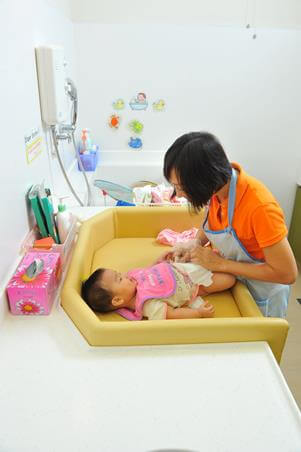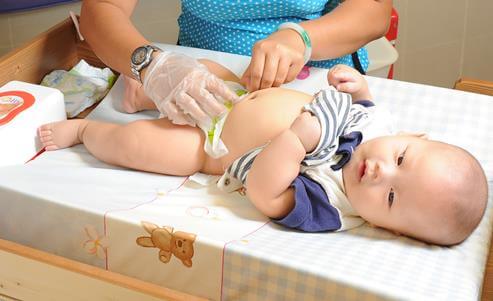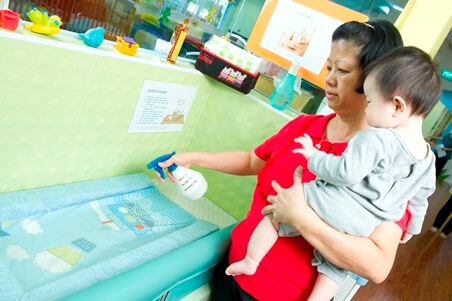Diaper Duty

Putting on baby's diaper for the first time is a rite of passage for all parents. It's a simple act, but one that encompasses a brimful of love and tenderness as you look baby in the eye, talk gently about your actions, coo and nuzzle, all the while manipulating a professional clean-up.

Diapers, like milk bottles and toys, are a vital part of the parenting journey. Most children stay in diapers for the first two years of their life, at the very least. Assess how many diapers your child goes through in a day, do some calculating and gosh... that's a whole lot of diapers you'll be needing!
GETTING STARTED
To facilitate smooth diapering, place all your diapering supplies in one spot within easy reach. A shelf, small table or basket is ideal. Things you will need include a changing mat, wet wipes (these should be alcohol-free and unscented), cotton balls, a container of lukewarm water, diaper cream and of course, a stash of baby diapers. Before you execute a diaper change, wash your hands and make sure you have everything you need before you start. Never leave your baby alone or turn your back on him, even for a second, as babies have been known to roll off a bed or changing table.
KEEP IT CLEAN
How to clean baby during a diaper change depends on how much there is to clean. Lift baby's legs slightly - by the ankles - and gently clean baby's diaper area with wet wipes. To clean up after a poo, wet cotton balls in water, squeeze out excess water and delicately wipe baby's bottom with it. Follow up with wet wipes. If your baby has sensitive skin, cotton balls are a good option in place of wet wipes.

Always clean from front to back, especially for girls. Do not clean from back to front as this could lead to the spread of bacteria, causing urinary tract infections. When cleaning baby boys, place a clean diaper over the penis as exposure to air can cause them to urinate, sending an unexpected shower your way.
Once baby is clean and dry, apply diaper cream, open a new diaper, slide it under baby's buttocks, fold the front part of the diaper between baby's legs and secure both sides with the tabs. Make sure the tabs aren't fastened too tightly.

Bag and dispose soiled diapers responsibily. Wash your hands thoroughly after each change to prevent the spread of germs. Disinfect the diapering area with each diaper change.
DIAPER RASH
If you notice red or pink bumps on baby's diaper area, it's probably diaper rash, caused by irritants like stools, urine and bacteria. To prevent and treat diaper rash, which usually occurs on the bottom, apply diaper cream (choose one containing zinc oxide) after each diaper change. Apply evenly on the affected area and in between the creases by the legs. The cream serves as a barrier against moisture. Another way to prevent rash is to keep baby clean and dry by changing diapers frequently. You can also air out baby's skin by letting him go diaper free for short periods of time each day.
DISPOSABLE VS CLOTH DIAPERS

For convenience and ease of use, nothing beats disposable diapers. There is still some debate as to whether reusable cloth diapers are more environmentally friendly than disposable diapers. Cloth diapers require plenty of washing and rinsing, preferably in hot water. Diapering baby while you're on the move may also be harder to manage with a cloth diaper. Should your baby require a diaper change while you're out and about, you'll have to bag the soiled diaper and bring it home to wash. Cloth diapers too, have come a long way. Modern versions feature Velcro buttons and snaps, doing away with the need for fussy safety pins.
PULL-UP DIAPERS
To prepare your child for toilet training, switch to pull-up diapers (also known as training pants). The elastic waist, underwear-like design and absorbancy allow children to get comfortable with pulling their diaper up and down, easing them into the potty-training stage, which usually happens between the ages of two to three.
Remember not to put pressure on your child. Be patient as toilet training takes time and is dependent on your child's readiness.
You may also like

From Cabin to Classroom: Journey of an Outstanding Early Childhood Educator
The PDP modules allowed me to get creative with lesson ideas and keep up with the ever-changing Early Childhood sector.

Ms Farhana Binte Mohamed Hassan
Early Years Educator - PCF Sparkletots @ Pioneer Block 987D (CC)

More Than Just a Place for Food
Young children are highly inquisitive, and learn most effectively with activities that allow exploration and experimentation.

Kinderland @ Yio Chu Kang

Little Fingers Create Great Art - A Community Project by Kinderland and Skool4kidz
I believe this collaborative effort is a very meaningful contribution to the SG50 celebrations.

Kinderland and Skool4Kidz